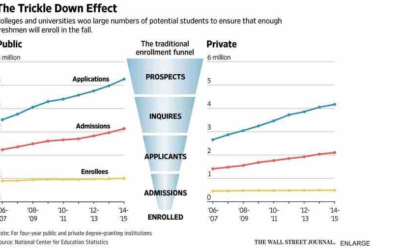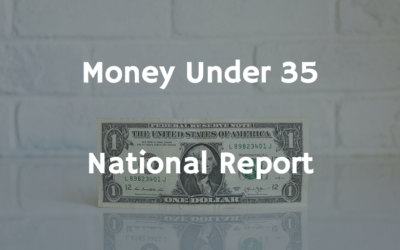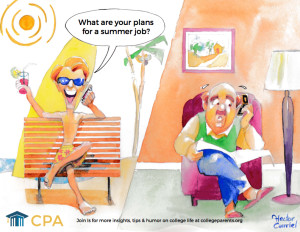
Just mention the words “college admissions,” and the anxiety level for some future college parent households rises as quickly as the spring pollen count outside their front doors.
Part of that anxiety, no doubt, is being driven by a recent spate of high-profile newspaper articles, followed inevitably by their cribbing on television or radio news programs, all of which are collectively making the point that college admission is harder than ever.
According to an article in the New York Times – the 2016 data is still largely anecdotal but “applications at more than 70 percent of colleges have increased for 10 of the past 15 years. The number of students using the Common Application — an online application that can be submitted to multiple colleges with a single keystroke — rose to 920,000 through mid-April, compared with 847,000 at the same time last year, said Aba Blankson, a spokeswoman for the Common Application”
In addition, the Wall Street Journal also published an article that demonstrates the Trickle Down Effect of increased marketing activities by colleges and universities. This chart reveals that the many admissions mailings your students may receive are all part of a well designed effort to increased the perceived selectivity of particular schools. 
Is it Harder Than Ever?
So is it harder than ever? We have to parse the question first, in order to answer it best. Our goal is not to make you feel better or worse, but to have you feel empowered, to know that you are aware of all the factors contributing to the perceived college admissions squeeze.
First of all, it is true that college admission at some highly selective schools is more difficult than ever. Increasing numbers of international students combined with a larger number of graduating high school students that are prepared for college have created more qualified applicants while the entering class size at most institutions have remained constant. That is partly the result of demographics. There are more students in the high school graduation pipeline, more students every year apply to college and more students are aware of and interested schools such as the Ivies on the East Coast, Northwestern and its ilk in the Midwest and Stanford and others of similar academic “brand strength” out West.
But when you take those highly selective schools and others like them, and add in all other universities that take less than one-half of their applicants, you come up with a figure of about 150 institutions, or less than five percent, of the more than 3,500 non-profit colleges and universities across the country. Now these are the 150 schools, of course, that get most of the media attention, especially in publications such as The New York Times, The Washington Post, and USA Today, not surprisingly in my view, since those colleges and universities are represented in high numbers with alumni among the ranks of reporters and editors at those publications.
But our message to you is: do not despair if your child does not attend, was not this year accepted by or is unlikely in future years to be accepted by one of those selective institutions.
It sounds like a cliché, but there really is a college for everyone. Just as a “mid-major” school like George Mason can enter into the “Final Four” of college basketball, a math or science major from one of the thousands of schools offering accredited degree programs can enter into the job or graduate school market with a high degree of confidence in his or her credentials.
In fact, David Hawkins, the executive director for educational content and policy at the National Association for College Admission Counseling, states “that to some degree, both colleges and students were overreacting. Colleges do so by engaging in what he called “an arms race” toward higher selectivity in an effort to improve their rankings, and students by applying to so many colleges. In the end, he said, the average acceptance rate at four-year colleges has remained stable at about 65 percent nationwide.”
College Parents of America suggests that the key is for families to encourage help their students identify the schools they are most sincerely interested in. In fact, NACAC reports that more schools are also marketing their campuses more aggressively to widen the applicant pool while, when making admissions decisions, putting greater weight on how serious students are about attending. In the latest NACAC survey, colleges attributed more importance to applicants’ so-called demonstrated interest than in class rank or teacher recommendations.
Remember There are Many Outstanding Colleges: This may sound heretical, but for the 3000+ colleges and universities out there that do take at least 50 percent of their applicants (and for at least a couple of thousand that 50 percent is even higher), the college admissions process should not be that stressful to you at all. That is, of course, unless you get stressed by having too many choices.
These thousands of less-selective schools are more like the tens of thousands of hotels out there across America; they are trying to fill beds. In the hotel industry, an empty room, on any given night, is a lost revenue opportunity forever. In the “industry” of college admissions, an empty student slot, for any given semester, is a lost revenue opportunity forever.
Assuming that your child has or will fulfill the basic high school graduation requirements, then there is a likely a school out there that will gladly accept him or her to “fill a bed” or, if close to home, a classroom chair for the semester.
And that’s OK. The vast majority of U.S. college students, more than 80 percent, attend a public college or university within their home states. And with the difficulty of gaining acceptance to the flagship universities within those states (there we go raising anxieties again), this really means that most students are going to school at the regional state university or local community college right in their own backyard. Yes, getting into some colleges in the U.S. is harder than ever. But getting into, and performing well, in the vast majority of schools in the U.S. is still pretty much a wide-open book, ready to be written by your sons and daughters, the current and future college students of America.



